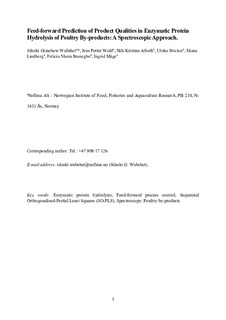Feed-Forward Prediction of Product Qualities in Enzymatic Protein Hydrolysis of Poultry By-Products: a Spectroscopic Approach
Wubshet, Sileshi Gizachhew; Wold, Jens Petter; Afseth, Nils Kristian; Böcker, Ulrike; Lindberg, Diana; Ihunegbo, Felicia Nkem; Måge, Ingrid
Journal article, Peer reviewed
Accepted version
Permanent lenke
http://hdl.handle.net/11250/2565977Utgivelsesdato
2018Metadata
Vis full innførselSamlinger
- Artikler / Articles [1449]
- Publikasjoner fra CRIStin [2518]
Originalversjon
10.1007/s11947-018-2161-ySammendrag
Enzymatic protein hydrolysis (EPH) is one of the industrial bioprocesses used to recover valuable constituents from food processing by-products. Extensive heterogeneity of by-products from, for example, meat processing is a major challenge in production of protein hydrolysates with stable and desirable quality attributes. Therefore, there is a need for process control tools for production of hydrolysates with defined qualities from such heterogeneous raw materials. In the present study, we are reporting a new feed-forward process control strategy for enzymatic protein hydrolysis of poultry by-products. Four different spectroscopic techniques, i.e., NIR imaging scanner, a miniature NIR (microNIR) instrument, fluorescence and Raman, were evaluated as tools for characterization of the raw material composition. Partial least squares (PLS) models for ash, protein, and fat content were developed based on Raman, fluorescence, and microNIR measurements, respectively. In an effort to establish feed-forward process control tools, we developed statistical models that enabled prediction of end-product characteristics, i.e., protein yield and average molecular weight of peptides (Mw), as a function of raw material quality and hydrolysis time. A multiblock sequential orthogonalised-PLS (SO-PLS) model, where spectra from one or more techniques and hydrolysis time were used as predictor variables, was fitted for the feed-forward prediction of product qualities. The best model was obtained for protein yield based on combined use of microNIR and fluorescence (R2 = 0.88 and RMSE = 4.8). A Raman-based model gave a relatively moderate prediction model for Mw (R2 = 0.56 and RMSE = 150). Such statistical models based on spectroscopic measurements of the raw material can be vital process control tools for EPH. To our knowledge, the present work is the first example of a spectroscopic feed-forward process control for an industrially relevant bioprocess.
